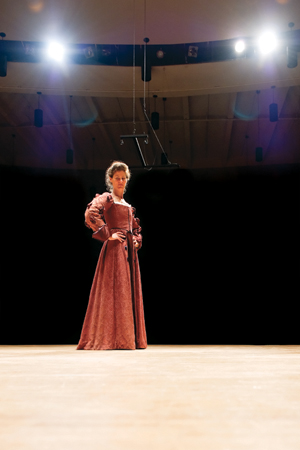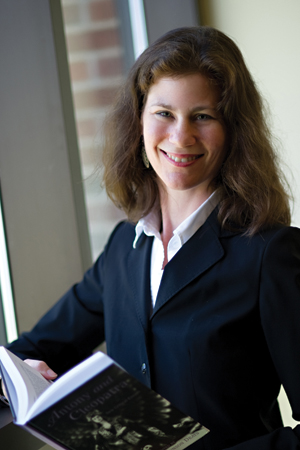 Dr. Marguerite Tassi
Dr. Marguerite Tassi
Professor, English
Nothing hurts a woman more than a bad reputation.
As for that ravenous tiger, Tamora,
No funeral rite, nor man in mourning weed,
No mournful bell shall ring her burial,
But throw her forth to beasts and birds to prey:
Her life was beastly and devoid of pity,
And being dead, let birds on her take pity.
– William Shakespeare, “Titus Andronicus”
In this closing speech from Shakespeare’s “Titus Andronicus,” Lucius Andronicus, the new Roman emperor, reflects the way audiences and scholars typically view Tamora, the Goth queen, who has spent the majority of the play pursuing her vendetta against the Andronici family. As UNK English professor Dr. Marguerite Tassi points out, however, Lucius’ harsh judgment tells only part of the story of a woman’s revenge.
As Tassi sees it, Tamora’s drive for revenge stems not from innate savagery or evil, but rather from a queen’s feeling of dishonor and a mother’s sense of injustice. Her son has been sacrificially slaughtered by the Roman general, Titus Andronicus. Out of her bereavement, out of her sense of injury arise maternal fury and vengefulness.
 Revenge, as Tassi explains in her forthcoming book “Women and Revenge in Shakespeare: Gender, Genre, and Ethics” (Susquehanna University Press), is the concern of women as much as it is that of men, only women tend to practice a more varied art and nuanced ethics of revenge than men do. According to Tassi, their revenge reflects their social circumstances as women, their desire to transcend helplessness and, at times, their love of justice.
Revenge, as Tassi explains in her forthcoming book “Women and Revenge in Shakespeare: Gender, Genre, and Ethics” (Susquehanna University Press), is the concern of women as much as it is that of men, only women tend to practice a more varied art and nuanced ethics of revenge than men do. According to Tassi, their revenge reflects their social circumstances as women, their desire to transcend helplessness and, at times, their love of justice.
In her book, Tassi addresses a number of provocative questions: Can there be a virtue in vengeance? Can revenge do ethical work? Can revenge be the obligation of women? She argues that the often marginalized stories of women’s revenge constitute a long-standing subversive element in Western literature, and that this less visible tradition comes into focus when critical attention is given to women’s preoccupations with honor and shame, justice and revenge, moral outrage and ethical response. According to Tassi, critics tend to categorize Shakespeare’s women as victims, helpless tragic figures, evildoers and witty heroines, often ignoring the subtle ways women speak and act to make their ethical claims.
“My book serves as a vindication for women,” Tassi said, “in that it explores ways in which Shakespeare’s female characters seek to vindicate themselves, and their female kin and friends.” By looking at female characters’ concerns for the integrity of women, family, community and the larger cultures to which they belong, she demonstrates how “often, revenge is the consequence of those concerns.”
Set for publication in early 2011, “Women and Revenge in Shakespeare” will be Tassi’s second book. Her first, “The Scandal of Images: Iconoclasm, Eroticism, and Painting in Early Modern English Drama,” came out in 2005. Her articles have appeared in numerous refereed journals, and she is a veteran reviewer of scholarly books and theater productions. Her most recent reviews have been of major Shakespeare productions, including Rupert Goold’s “Macbeth” (with Patrick Stewart in the title role) at New York City’s Lyceum Theatre in 2008.
Her latest research has been fueled by an understanding that humans have definite, but dueling, ideas about revenge. Particularly in Western civilization and literature, revenge is “officially” seen as a barbaric instinct that can only bring ruin or more violence. While it is true that revenge can be dangerous, and avenging characters often pay a price for their version of justice, Tassi asserts that a more balanced ethical perspective needs to be applied to revenge literature.
 From Queen Hildeburh in “Beowulf” to Uma Thurman’s character in “Kill Bill,” Western literature and film represent characters – often women–who take action against those “who’ve done them wrong.” Often, these women take revenge on men who have hurt their families. What these characters demonstrate, according to Tassi, is that the revenge ethic is deeply rooted within the human psyche and connected to our innate sense of justice.
From Queen Hildeburh in “Beowulf” to Uma Thurman’s character in “Kill Bill,” Western literature and film represent characters – often women–who take action against those “who’ve done them wrong.” Often, these women take revenge on men who have hurt their families. What these characters demonstrate, according to Tassi, is that the revenge ethic is deeply rooted within the human psyche and connected to our innate sense of justice.
“We see often in literature that the impulse to revenge is linked to problems of injustice and unpunished crime,” she said. “As readers and audience members, we understand on an elemental level when an injustice has been done, and we want to see wrongdoers punished. What Shakespeare’s plays tap into is the universal desire to see justice done.”
“What my book does is give ethical weight to revenge as a possible mode of justice,” she said, adding that while readers may find the outlook disquieting, they will also be compelled to ask themselves whether there are productive, and ethically viable, ways to take revenge.
“The long-standing tradition of virtue ethics initiated by the works of Aristotle and Aquinas has recognized the virtues of vengeance,” Tassi said. “These philosophers articulate the conditions under which revenge and its passions (anger, moral outrage, resentment) gain moral credence.”
Tassi found that Shakespeare’s women, more often than not, met the conditions for virtuous vengeance. Cordelia in “King Lear” offers a striking example of Aquinas’ noble avenger whose love of justice and outrage against evil lead her to make war against her sisters. In Shakespeare’s comedy, “The Merry Wives of Windsor,” the wives offer yet another example; they take a playful revenge against Falstaff after he assails their virtue.
“They use revenge in a constructive manner to teach a sexual predator a lesson, protect wifely chastity and reputation, and bring their community together to reaffirm its values,” she said.
In reaching her conclusions, Tassi looked at both Shakespeare’s comedies and tragedies, and used a blend of analytical approaches and methods. “With Shakespeare, you can’t escape doing as much linguistic analysis as possible—language is revelatory and deepens our understanding of dramatic character,” she said. But her readings were informed as well by the virtue ethics tradition, anthropology and classical scholarship.
Tassi also used her background in performance. A self-professed theater buff since high school, she gained new insight into Shakespeare’s work through a 2002 seminar titled “Shakespeare’s Playhouses: Inside and Out.” Tassi was awarded a National Endowment for the Humanities summer grant to attend the seminar, located at the reconstructed Blackfriars playhouse in Staunton, Va., and the Globe Theater in London. Among the lessons she learned, Tassi said, was that no two performances of a Shakespearean play are the same.
“The text is fluid; performance is fluid,” she said. That leaves room for actors, directors – and scholars – to approach characters in new ways, as long as the text supports each new interpretation.
For example, Tassi said, the character of Lavinia in “Titus Andronicus” is usually seen as a symbol of female victimization. Raped and mutilated by Tamora’s sons, she is the victim of Tamora’s revenge. Late in the play, though, she names her victimizers and leads her family to perform a revenge rite that reverses the roles of victim and victimizers. She holds the bowl that catches her violators’ blood as her father cuts their throats. In one modern production, the director chose to play up Lavinia’s empowerment as an avenger. At the end of the play, the actress came to the front of the stage and held up her bloody arms in a sign of triumph.
“In this performance, theatergoers experienced revenge’s satisfaction,” Tassi said. “The moment was cathartic. The scales of justice had been rebalanced by the victim. Her revenge enacted a harsh kind of justice. Today’s audiences want to see victims strike back. Perhaps Shakespeare’s audiences did too. On another level, what that performance suggested to me is that there are so many possibilities for interpreting Shakespeare’s women.”
After finishing her first book, Tassi said, she was uncertain about what new area of research she would investigate next. She did have a long-standing interest in the role feuds played in Western literature. When a colleague, the late Dr. John Damon, invited her to give a guest lecture on feuds to his graduate seminar on “Beowulf,” the experience was positive for Tassi and sparked curiosity from students.
Her work on “Beowulf,” she said, provided the perfect jumping-off point for a rich, exciting project that would also satisfy the students’ need for a fascinating and morally complex subject for classroom discussion. Tassi chose to ask anthropological questions about the poem’s women. What role were they expected to play in the feuds that fuel the poem’s action? What actions, and reactions, did their culture and their place in society demand of them?
When Tassi analyzed the work in that way, she found herself viewing female characters with greater cultural precision. In their words and actions – such as Queen Hildeburh’s lamentation at the funeral of her brother and her son – she began to see subtle aspects of medieval culture revealed. She realized that revenge was the only available system of justice, and, despite their seemingly small roles, women were as invested in feuding as men were. When their families’ lives and reputations were at stake, they felt ethically justified in provoking revenge.
That was a surprising revelation, Tassi said, and she was further surprised when she narrowed the focus of her research to prepare a course on Shakespeare and revenge. “I was reading a lot of scholarship on revenge, and I noticed that very little of it emphasized women,” she said. That led her to write a journal article on one of Shakespeare’s comedies, “Twelfth Night,” which features an infamous revenge plot initiated by a minor, yet important, female character, Maria. It was clear by then, however, that there was much more that needed to be written about Shakespeare’s female avengers.
“I was astonished by this lack in the scholarship. I was very clear with myself when I got into the field of early modern literature that I would not write a book on Shakespeare,” Tassi said, thinking that after four centuries there was not much room for new scholarship on his plays.
Tassi said she is equally surprised to find herself writing a book centered on female characters and ethics, because her interests before this book focused on the subtle connections between theater and the visual arts, and between words and images in literature. Her doctoral dissertation, for example, had explored how English Renaissance writers responded to the painter’s technique of perspective in their poetry.
“While I follow a similar principle to that of critic Kenneth Burke, who says we should ‘use all that there is to use’ by way of critical methodology, I think it would be fair to say that I have joined forces with feminist revisionist scholars who bring empathy to their criticism, look beyond ideological camps, and focus squarely on female agency.”
While studying Shakespeare’s women, Tassi also pursued ideas of revenge on a larger scale through a seminar course titled “Wild Justice: Women and Revenge in Western Literature,” first offered in 2008. She said that class discussions have helped her clarify her ideas – not only for her new book on Shakespeare, but for her next one as well.
For that book, she said she plans to expand her research to look, as the course does, at women and revenge throughout Western literature, noting that she wants to focus not only on the classical revenge tradition, but also on contemporary stories and film. She cited the popular Millennium series by Stieg Larsson as an example. The series features Lisbeth Salander, a fierce, angry girl with a dragon tattoo, who retaliates against men who harm women.
Tassi said that her enthusiasm and commitment to her work infuse her teaching. “What is most remarkable,” she said, “is how my students have taught me so much over the course of this project.” Her openness to students’ perspectives and her emphasis on collaborative learning have helped earn her several awards, including a Pratt-Heins Foundation Teaching Award in 2009.
In addition, Tassi said that her students have shown her that the questions literature poses about the ethics of revenge are universal, yet culturally specific, and that there is much room for debate. Contemporary preoccupations with injustice, female victimization, terrorism and the limits of the law naturally make their way into her students’ conversations.
“As human beings, we all feel the passions associated with revenge; we all want to see justice done,” she said. “What constitutes justice, how revenge can accomplish something socially productive rather than destructive…these are difficult questions for us today, and they were difficult questions for Shakespeare and his contemporaries.
“When I see how passionate my students are about such questions, I feel there’s an audience for my work and that this ongoing project on women and revenge matters…tremendously,” she concluded.